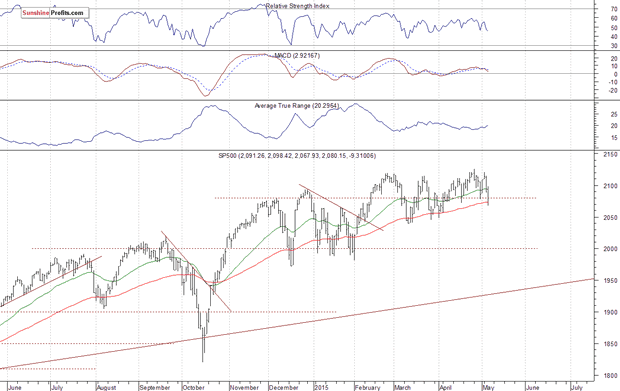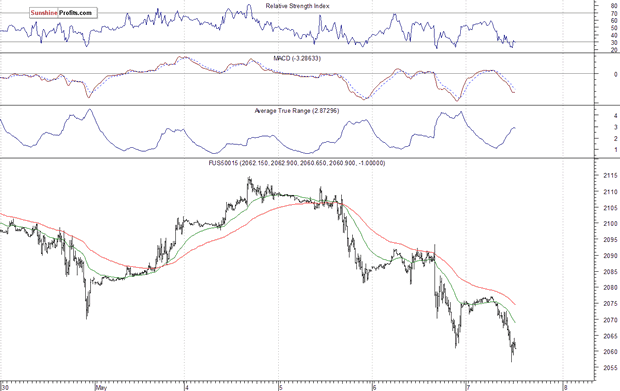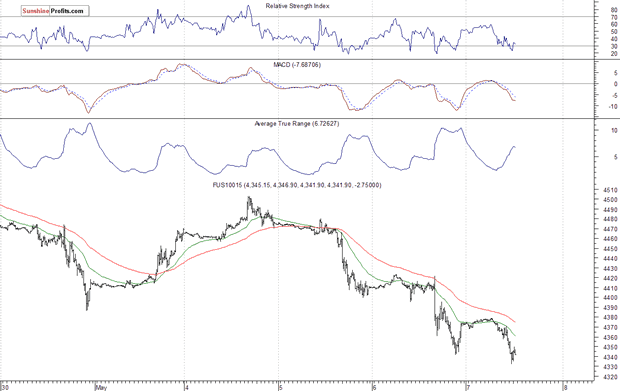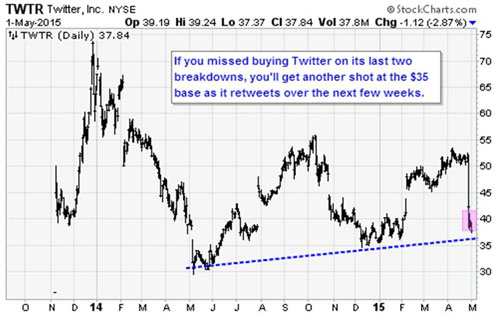Stocks & Equities
The disconnect in the US stock market just keeps getting bigger
A new Bank of America Merrill Lynch survey published Thursday finds that US investors have pulled $99B out of equities year to date — including net outflows in 11 of the past 12 weeks — despite stock prices continuing to break new record highs.
This week also saw the biggest outflows from equity ($17.2bn) and high-yield bond funds ($2.6bn) so far this year. This data follows a similar report from BAML last month which showed investors pulled $79 billion from the stock market this year and 9 of 10 weeks to that point.
And as this imbalance grows, Bank of America writes that the risk of something we haven’t seen in the market in years will continue to grow: a correction.’

Stocks Continue Their Downtrend Following Worse-Than-Expected Economic Data Releases
Briefly: In our opinion, speculative short positions are favored (with stop-loss at 2,140, and profit target at 1,980, S&P 500 index)
Our intraday outlook is bearish, and our short-term outlook is bearish:
Intraday outlook (next 24 hours): bearish
Short-term outlook (next 1-2 weeks): bearish
Medium-term outlook (next 1-3 months): neutral
Long-term outlook (next year): bullish
The U.S. stock market indexes lost 0.5-0.7% on Wednesday, extending their short-term downtrend, as investors reacted to economic data releases. Our yesterday’s bearish intraday outlook has proved accurate. The S&P 500 index is close to support level of 2,070-2,080. On the other hand, level of resistance remains at around 2,100. There have been no confirmed negative signals so far, however, we still can see negative technical divergences:
Expectations before the opening of today’s trading session are negative, with index futures currently down 0.7-0.8%. The main European stock market indexes have lost 1.5-2.1% so far. Investors will now wait for some economic data announcements: Challenger Job Cuts report at 7:30 a.m., Initial Claims at 8:30 a.m. The S&P 500 futures contract (CFD) is in an intraday downtrend, as it extends its short-term move down. The nearest important support level is at 2,030-2,050 and resistance level is at around 2,080, marked by recent local high, as we can see on the 15-minute chart:
The technology Nasdaq 100 futures contract (CFD) extends its short-term downtrend, trading below the level of 4,350. The nearest important level of resistance is at around 4,360-4,380, as the 15-minute chart shows:
Concluding, the S&P 500 index continued its short-term downtrend yesterday, as investors reacted to worse-than-expected economic data announcements, among others. We continue to maintain our speculative short position (2,098.27, S&P 500 index), as we expect a downward correction or an uptrend reversal. Stop-loss is at 2,140, and potential profit target is at 1,980. You can trade S&P 500 index using futures contracts (S&P 500 futures contract – SP, E-mini S&P 500 futures contract – ES) or an ETF like the SPDR S&P 500 ETF – SPY. It is always important to set some exit price level in case some events cause the price to move in the unlikely direction. Having safety measures in place helps limit potential losses while letting the gains grow.
Thank you.
(1) Genworth MI Canada Inc (TSE:MIC.CA) — 4.5% YIELD
Genworth MI Canada, through its subsidiary Genworth Financial Mortgage Insurance Company Canada is engaged in mortgage insurance in Canada, and is regulated by the Office of the Superintendent of Financial Institutions Canada as well as financial services regulators in each province.
 While there is often some reference to the challenging nature of Emerging Markets, they have become an established part of the asset management landscape. In the past they have offered opportunities wrapped up in high levels of economic growth, positive demographics including young populations and aspiring middle classes, and expanding outlets for multinational corporations confronting aging populations and flaccid growth prospects in advanced economies. Challenges do remain, but acceptance of Emerging Markets for a wide range of investors is there – even with the recent volatility related to the collapse in commodity prices since 2014.
While there is often some reference to the challenging nature of Emerging Markets, they have become an established part of the asset management landscape. In the past they have offered opportunities wrapped up in high levels of economic growth, positive demographics including young populations and aspiring middle classes, and expanding outlets for multinational corporations confronting aging populations and flaccid growth prospects in advanced economies. Challenges do remain, but acceptance of Emerging Markets for a wide range of investors is there – even with the recent volatility related to the collapse in commodity prices since 2014.
The word “challenging” however is more apt with Frontier Markets, the sizable swath of countries in Africa, Asia, the Middle East, and Latin America and the Caribbean. Lesser developed, less regulated and more prone to the whims of political risk, Frontier Markets are indeed challenging. The names in this group include Bangladesh, Egypt, Jamaica, Myanmar, Mongolia, Nigeria, Pakistan and Vietnam. Not in the Frontier Market group are Brazil, China, Colombia, Mexico, India or Indonesia, which are classified as Emerging Markets.
Frontier Markets are in the realm of the more adventurous, who are willing to stomach a fair share of ups and downs and certainly are not something that would be recommended for conservative investors. However, Frontier Markets are going to remain attractive for the very basic reason that they offer yield, which is in very short supply in more traditional markets. Interest rates in North America, Europe and Japan are historically low. Additionally, many Frontier Markets are not as closely linked to international markets as are Emerging Markets, which provide some degree of a buffer to potential crises – which there are more likely to be forthcoming in the next few years.
The macroeconomic and investment picture has improved for such countries as Egypt, Myanmar and Jamaica, while Mongolia is wrapped up in disputes with mining companies, Vietnam has lapsed on its privatization program and it is questionable whether it will privatize its target of 289 state-owned enterprises in 2015, and Libya has fallen apart (underscoring the dangers of investing in this sector).
Egypt has probably undergone one of the most significant shifts. The Middle Eastern/African country transited from being a politically unstable country, with a shell-shocked economy to a country that appears to have regained some of its footing as a regional leader. In 2014, real GDP growth was a meager 2.2%. The International Monetary Fund (IMF) is now forecasting real GDP expanding at 4.0% in 2015 and 4.4% in 2016 and is looking for unemployment to fall from 13.4% in 2014 to 12.5% in 2016. Egypt’s progress was noted by the IMF’s Managing Director Christine Legarde, who in early April 2015 sent President Abdel Fattah al-Saisi praising the Egyptian government’s economic reform measures.
Egypt’s progress on the economic front is also expected to increase investment in the economy. The country also benefits from $12.5 billion in aid collectively from Saudi Arabia, the United Arab Emirates, Kuwait and Oman. Even the rating agencies have acknowledged Egypt’s improvement, with Moody’s in April 2015 joining Fitch and Standard & Poor’s in upgrading the sovereign (from Caa1 to B3 with a stable outlook).
Myanmar is probably one of the most exciting of Frontier Markets stories. What was once an isolated economy, dominated by Chinese investment, has opened up its political and economic system to a degree and economy. Both Western and other Asian investment has flowed into the country. According to the Myanmar Investment Commission, FDI in the first five months of the fiscal year stood at $3.32 billion, a 113 percent year-over-year rise and is expected to cross $5 billion in 2015. The key areas for FDI are telecommunications, oil and gas, real estate and hotels. Although challenges remain, Myanmar will probably maintain itself as a strong candidate for Frontier Market investors. As of now, however, there are few pure-play securities offering exposure to Myanmar for the foreign investor, including Yoma Strategic Holdings Ltd. and Interra Resources, Ltd, which are listed in Singapore, though that will likely change as the economy continues to open and the Myanmar Stock Exchange launches later this year. Nigeria is another country with tremendous potential, with attractive demographics and an aspiring middle class. It needs a massive amount of infrastructure upgrades, especially in areas of transportation and communications. The country is Africa’s largest economy, has a population of 177 million, with more than 50% living in cities and being below the age of 15 years of age. Elections were just held, in which the winner was the opposition leader. The challenge is that Nigeria’s new government must contend with the collapse in oil prices and revenues (not to mention foreign exchange reserves), endemic corruption, and the Boko Haram insurgency in the north. Investors should be watching Nigeria closely as it is likely to regain momentum, probably after further policy adjustments. One way that has been suggested to play Nigeria as well as South Africa and a number of other Middle Eastern countries is the telecom company MTN Group Limited.
Two other countries loom as Frontier Markets – Cuba and Iran. Both countries have considerable political issues surrounding them, are currently off the investment menu, and could see some type of internal upheaval. However, they have relatively youthful populations, Iran in particular. While we are not advocating either country as an investment, Cuba and Iran are very much part of the discussion on what is the next frontier. Indeed, the Herzfield Caribbean Fund Inc (CUBA) has long offered U.S. investors an option on the Caribbean, with the premise that Cuba will eventually be on the investment list and will offer opportunity. Because of current U.S. laws, CUBA does not own anything in Cuba, with its largest exposure to U.S., Panamanian and Mexican companies. Iran’s prospects are conditioned by political factors, namely whether Tehran and Washington can reach a final agreement on the Middle Eastern country’s nuclear program, which would trigger an end to sanctions. While Iran’s geopolitical policies complicate matters, the end of sanctions is seen as a lynchpin for strong economic growth, driven by better prospects for exports, pent up demand for imported goods, and the need for foreign direct investment. Part of the backdrop to this is that Iran has a large urbanized population of 81 million people, most of whom were born well after the 1979 revolution. Normalization of relations with the West could have a major benefit for the Iranian economy and could open up investment opportunities for foreign companies. That said, there remain considerable work before a final deal is concluded, if at all.
International markets will continue to be a challenge in 2015. There are a wide range of risk factors – Greece’s problems (we increasingly believe that a Greek exit from the Eurozone is likely), a Chinese economic hard landing (not likely but always seeming to threaten), and missteps at the Federal Reserve that could lead to what the IMF recently referred to as the threat of a “Super Taper Tantrum” when it raises rates (which we expect in September 2015). All of this has an impact on investment, as any of the risk events singularly would inject volatility into markets and occurring together could be a systemic threat. Nonetheless, looking over the medium and long term, Frontier Markets are for the hardy investors willing to assume the needed due diligence to reap the benefits of higher yields.
Scott B. MacDonald is the Head of Research at MC Asset Management Holdings LLC, a wholly-owned subsidiary of Mitsubishi Corporation. The views expressed here represent only the views of Dr. MacDonald and do not in any capacity reflect those of Mitsubishi Corporation.
One of Wall Street’s best known adages is the old “sell in May and go away” seasonal trick. The idea is that the six months starting in May — including the normally listless summer months — are among stocks’ poorest performers of the year.
It helps that it kind of rhymes. Just try to say, “Sell in April and … um … ” You see, nothing rhymes with April except maybe fatal and evil, so it would never make the cut for a cutesy adage. Same with February.
The folks over at the Stock Trader’s Almanac popularized the May-away strategy in 1986 and put hard numbers behind the old Street folklore: A $10,000 investment in the Dow Jones Industrials compounded to $816,984 for November through April in 64 years vs. a $221 loss over the same period for May through October. Since 1997, the Dow has climbed higher in May only seven times in the past 17 years, including 2013 and 2014.
What should investors expect in 2015?
The market has stalled over the last few months on Fed rate hike fears — fears that have diminished somewhat as the economic data has cooled. The Atlanta Fed’s GDPNow estimate for second-quarter growth is tracking at just 0.9 percent, suggesting the first-quarter weakness wasn’t just weather related. Corporate earnings have turned into a drag as well with big, high-profile misses by one-time social media up-and-comers Twitter (TWTR) and LinkedIn (LNKD) last week.
And investor sentiment is extended. According to calculations by Ed Yardeni of Yardeni Research, the Investor Intelligence Bull-to-Bear Ratio’s 52-week moving average has reached its highest level ever since the data series started in 1987.
But the two big dynamics that have driven stocks higher this cycle — an accommodative Fed and the flow of capital back to investors via share buybacks and dividends — look set to continue.
The Financial Times highlighted a few weeks ago that shareholders of the largest U.S. companies are set to receive a record $1 trillion in cash this year through dividends and buybacks. Last year, the total was $904 billion. And in the weeks to come, unless the macro data makes a massive turn to the upside, the Fed will be forced to acknowledge the economy just isn’t yet ready for higher rates — moving their expectations into alignment with where the futures market already is and unleashing a summertime rally of the type seen last year.
Partly fueling the rally will be the realization that most investors had 2015 completely upside down when looking ahead in late 2014. Remember how everyone thought the U.S. was the one strong economy in a world of weak growth elsewhere? It’s turned out that China GDP is running at around 5 percent, the euro zone is perking up finally with an infusion of QE and could see 2 percent growth, and Japan is even awakening in synch with a massive QE program.
Wouldn’t it be ironic if by midyear the consensus comes to believe the United States is the global goat rather than the lion? If the consensus then figures rate hikes will be pushed off to mid-2016, perhaps then U.S. stocks would join their counterparts overseas in finally kicking higher. Just a thought to put in your back pocket.
Best wishes,
Jon Markman


 Larger Image
Larger Image














